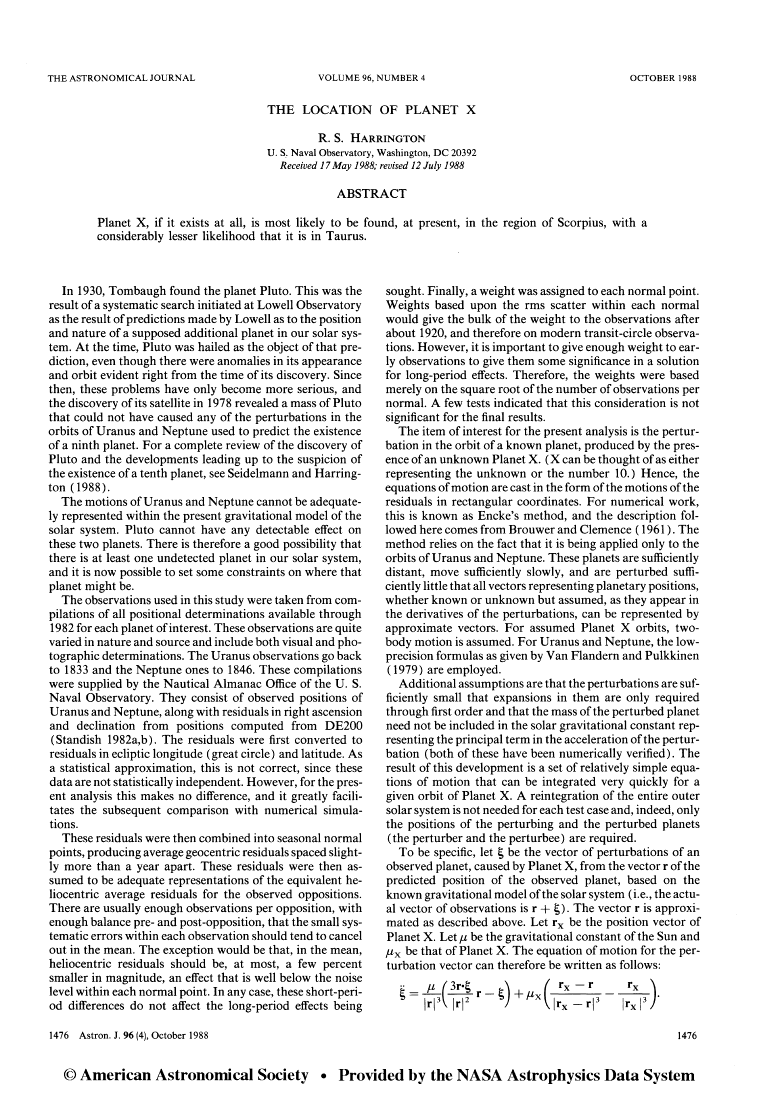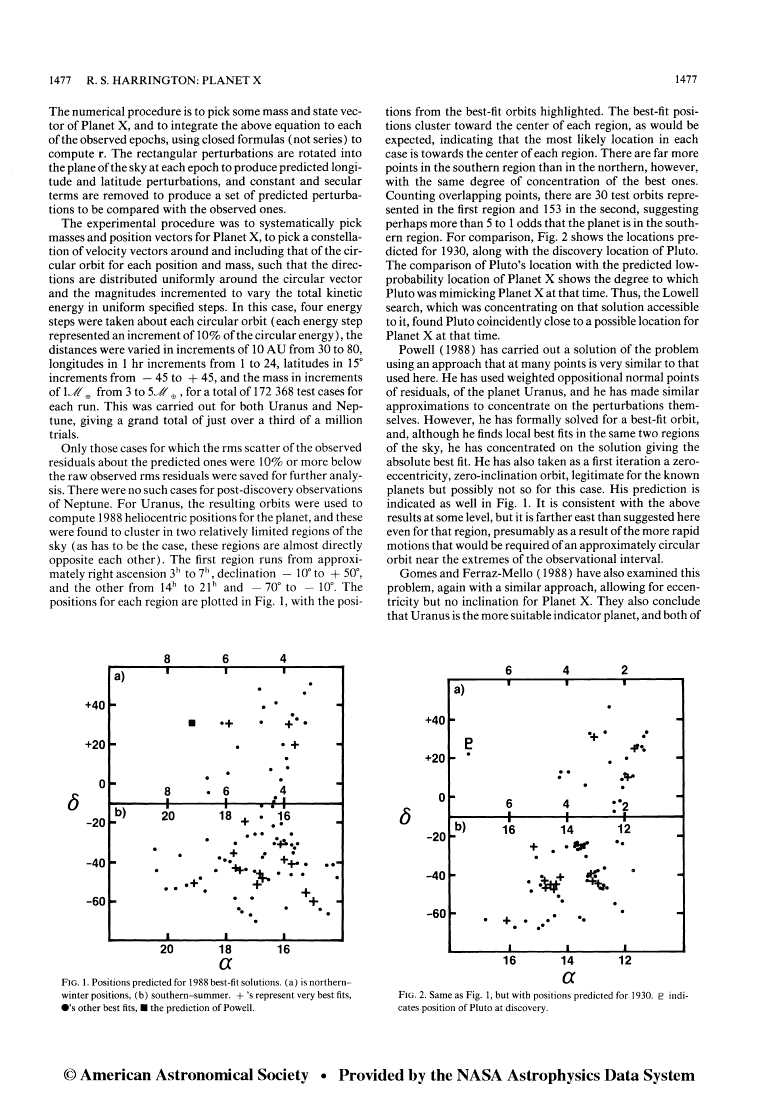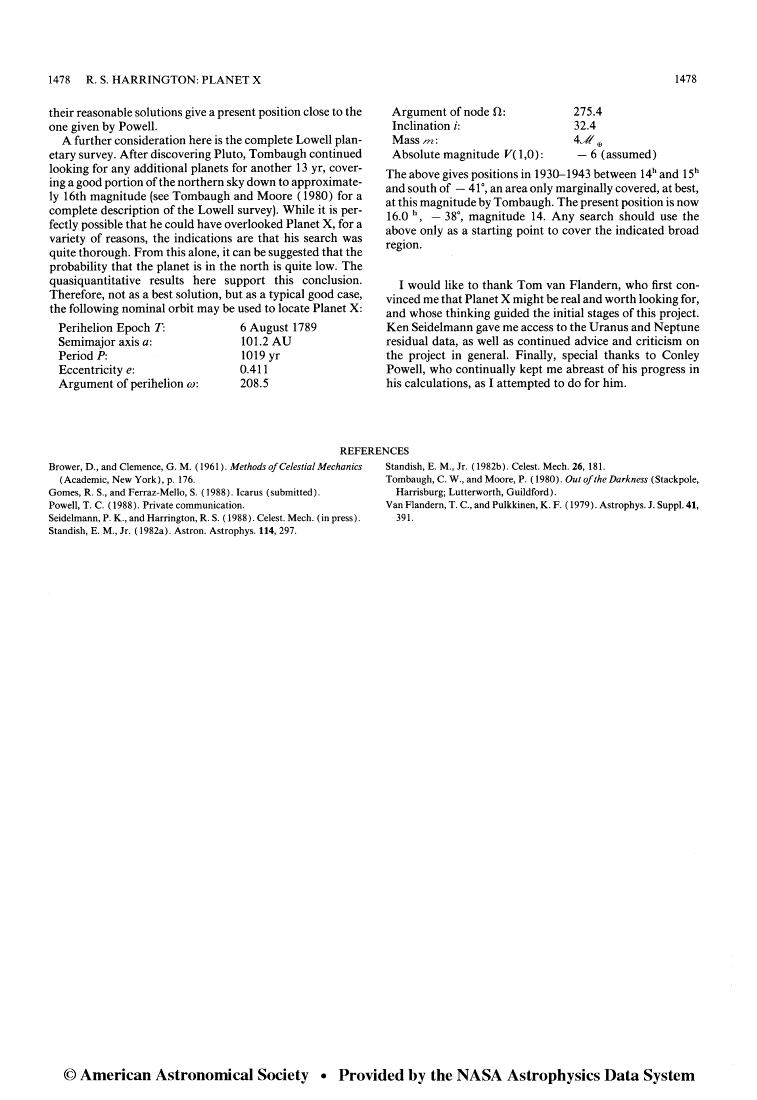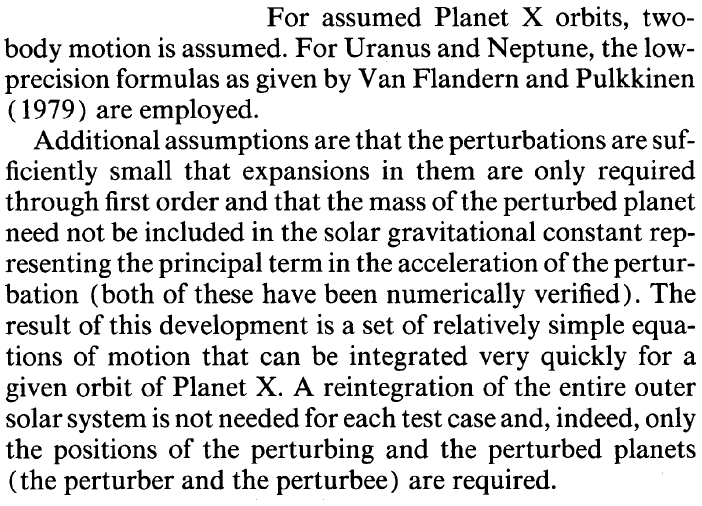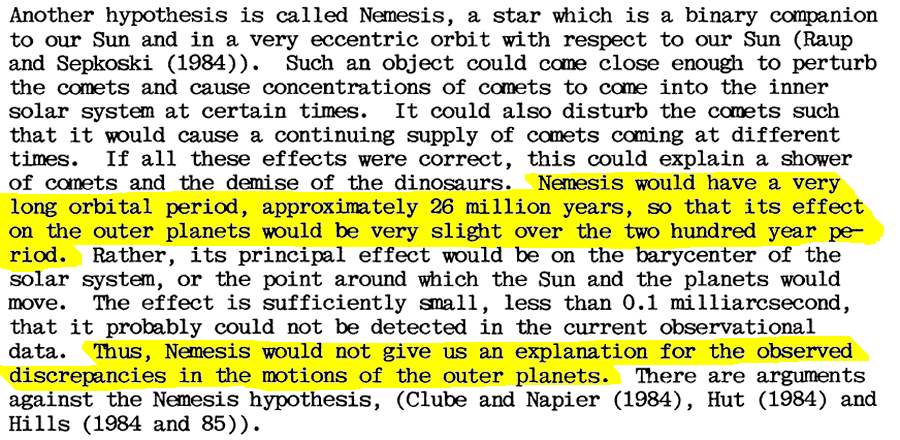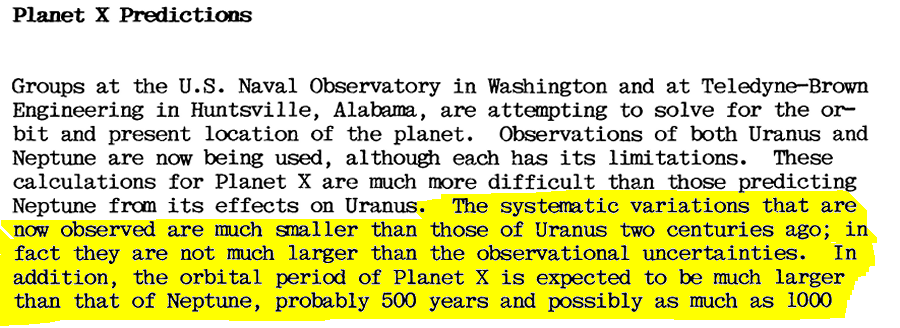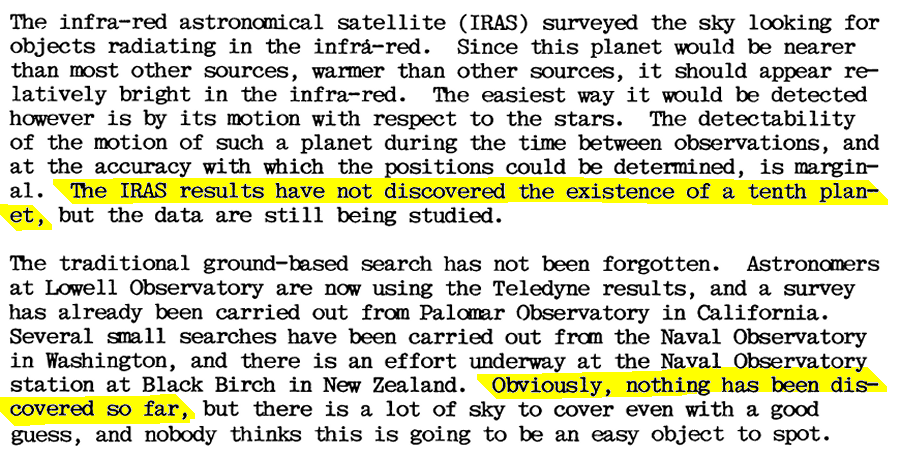|
|
||||||||||
|
R.S Harrington
The Planet X that Harrison was seeking was a small planet to account for the perturbations in the orbits of Neptune and Uranis... a body that would be WITHIN OUR SOLAR SYATEM already as these perturbations have been observed since Lowell in 1930 This is NOT the same as Nibiru... though it is used as proof that Robert Harrington was searching for Nibiru. The confusion between Nibiru and Planet X (meaning Planet 10 in the minds of Lowell and other astronomers) seems deliberate or ignorant at best. Besides does not Sitchen say Nibiru is the 12th Planet? Would that not be Planet XII? |
||||||||||
|
Search for Planet X Title: Search for planet X
Publication:
Publication Date: 10/1991
NASA/STI Keywords:
Abstract The observation of the region of the sky in which it is believed Planet X should now be, based on perturbations observed in the motions of Uranus and Neptune, was determined, and there was no reason to update that determination. A limited area of that region was photographed, and that will be continued. A given area is photographed with the twin 20 cm astrograph in New Zealand on two successive nights near the time that area is in opposition, and these plates are blinked in Washington to identify anything that has moved. The predicted region is in the south, which requires observations from a southern station, and it is in opposition in the April to June period, which means observations have not yet started for the year. Blinking will be done as soon as the plates are received in Washington. Document ID: NTRS 19920003598 |
||||||||||
|
..
Considerations on the stability of the solar system led Bob to collaborate with T.C. Van Flandern in studies of the dynamical evolution of its satellites, and to an eventual search for "Planet X", conjectured to lie beyond Pluto and to be responsible for small, unexplained, residuals in the orbits of Uranus and Neptune. Late in his career Bob seemed quite skeptical of such an object, however. Nevertheless, the program instituted at Flagstaff to photograph the outer planets and their satellites led to the spectacular discovery in 1978, by J.W. Christy, of Pluto's satellite. Bob's inspired guess that the period of revolution matched the already known period of light variation resulted in rapid determination of the orbital elements, and hence the mass of both planet and satellite. He served as a joint editor of four books, was a member of the AAS, the IAU (where he served on four commissions), the Planetary Society, and the Society of Sigma Xi. He also served on the astrometry team for the International Halley Watch, and on the local organizing committee for the 20th General Assembly of the IAU. Robert (Bob) Harrington died on Jan. 23, 1993 after a short, but determined, battle against esophageal cancer. He left his wife, Betty, two daughters, a sister, and his parents. http://ad.usno.navy.mil/wds/history/harrington.html Part 3 1972
Part 6 1974
Part 1 1975
Part 3 1976
Part 4 1978
|
||||||||||
|
Robert Harrington and Planet X Dr. Robert S. Harrington was an astronomer with the United States Naval Observatory. He had multiple theories on Planet X over the years including The Location of Planet X 1988 and The Search for Planet X 1991. He based his theories on the movements of the outer planets and a possible influence from an unknown body in the solar system. These published and publicly available papers by the Naval Observatory astronomer are even referred to by some Planet X proponents as "NASA internal documents"! Oddly, it is his death that the Planet X crowd refer to more often than his theories. This seems to stem from a white paper written by Neil Freer titled The Alien Question: An Expanded Perspective. In this white paper Freer wrote: "It is interesting that Harrington dispatched an appropriate telescope to Black Birch, New Zealand to get a visual confirmation, based on the data leading to the expectation that it would be below the ecliptic in the southern skies at this point in its orbit. On Harrington’s early death the scope was immediately called back --- as one observer noted, “almost before he was cold”. " Neil Freer is an English professor who has written several books about the works of Zecharia Sitchin. Zetatalk takes this a step further saying: "A Phil Schneider assassination is evident, as is the death of Robert Harrington". In Blindsided, Mark Hazlewood says: "What obvious
message do you think was sent to Stitchin,
Van Flandern and anyone else in the know, when
Harrington suddenly met
with an early death at the same time the scope was
being pulled back? Sometimes
an
Yes, more conspiracy theory on the cover-up of Planet X. The easy explanation why no astronomer or scientist will support the silly Zeta planet. Zetatalk recently added a new page on Harrington with a rambling conspiracy theory and the usual reference of "his cohorts sang whatever tune the CIA wanted" to justify why astronomers no longer feel that a Planet X exists. The truth of the
matter is that Robert Harrington died
January 23, 1993 of esophageal cancer. Nothing
mysterious or sinister
about this. There is also no evidence of a telescope
being dispatched to
Black Birch, New
In his book Genesis Revisited, Sitchin says: "On January 16, 1990, Dr. Harrington reported at the American Astronomical Society meeting in Arlington, Virginia, that the U.S. Naval Observatory team has narrowed its search for the tenth planet to the southern skies and has announced the dispatch of a team of astronomers to the Black Birch Astronomic Observatory in New Zealand." Note: this was 3 years before Harrington's death. Harrington in his 1991 paper The Search for Planet X wrote about the search already being underway and it would continue from New Zealand. Why New Zealand? Harrington's latest calculations showed that if Planet X existed it would be in the region of Centaurus and Hydra, a region which is too far south for Tombaugh to have searched in the 1930s. This is also NOT the location of the Zeta Planet X. Not even close. Are we looking at dishonesty here? Or simply more poor research? That is difficult to say. What is obvious is that the Planet X crowd does like to take the truth and twist it to suit their needs. |
||||||||||
|
On the problem of the search for Planet X based on its perturbation of the outer planets Gomes, R. S Title: On the problem of the search
for Planet X based
on its perturbation of the outer planets
NASA/STI Keywords:
LPI Keywords:
DOI: 10.1016/0019-1035(89)90144-9
SOURCE: Harvard Abstracts Also:
|
||||||||||
|
perturbation of the outer planets Gomes, R. S Document:
Title: On the problem of the search
for Planet X based
on its perturbation of the outer planets
Subject 640107 -- Astrophysics &
Cosmology-- Planetary
Phenomena; PLANETS-- COORDINATES;
ALBEDO;GRAVITATION;MASS;MATHEMATICAL
MODELS;NEPTUNE PLANET;ORBITS;PERTURBATION
THEORY;SOLAR SYSTEM;STARS;URANUS
PLANET
Description/Abstract:
SOURCE: OSTI.GOV |
||||||||||
|
A mathematical search for Planet X Powell, C. Title: A mathematical search for
Planet X
NASA/STI Keywords:
LPI Keywords:
Abstract
SOURCE: Harvard Abstracts |
||||||||||
|
Planet X and the stability of resonances in theNeptune-Pluto system Jackson, A. A.; Killen, R. M. Title: Planet
X and the stability
of resonances in the Neptune-Pluto system
NASA/STI
Keywords:
Bibliographic Code: 1988MNRAS.235..593J Abstract
SOURCE: Harvard Abstracts
|
||||||||||
|
Mass and orbit estimation of Planet X via a family of comets Neuhaeuser, R.; Feitzinger, J. V. Title: Mass and orbit estimation of
Planet X via a
family of comets
NASA/STI Keywords:
Bibliographic Code: 1991EM&P...54..193N Abstract
SOURCE: Harvard Abstracts |
||||||||||
|
Planet X - Fact or Fiction? Anderson, John Title: Planet
X - Fact or fiction?
NASA/STI
Keywords:
Bibliographic Code: 1988PlR.....8d...6A Abstract
SOURCE: Harvard Abstracts |
||||||||||
|
Planet X - The current status Seidelmann, P. K.; Harrington, R. S. Title: Planet X - The current status
Publication Date: 00/1988
NASA/STI Keywords:
Bibliographic Code: 1988CeMec..43...55S Abstract
SOURCE: Harvard Abstracts ...
Observed Perturbations and Anomalies ...
Hypothesis ...
Nemesis - Our Binary Companion ...
Theory of Relativity or Gravity Wrong ...
.... Planet X Predictions ...
|
||||||||||
|
Discussion of current status of Planet X Seidelmann, P. K.; Williams, C. A. Title: Discussion of current status
of Planet X
Publication: (BMFWF, Oesterreichische Forschungsgemeinschaft, Steiermaerkischer Wissenschafts- und Forschungslandesfonds, et al., Alexander von Humboldt Colloquium on Celestial Mechanics: Long Term Evolution of Planetary Systems, Ramsau, Austria, Mar. 14-18, 1988) Celestial Mechanics (ISSN 0008-8714), vol. 43, no. 1-4, 1987-1988, p. 409-412. Publication Date: 00/1988
NASA/STI Keywords:
Bibliographic Code: 1988CeMec..43..409S Abstract
SOURCE: Harvard Abstracts ...
Hypothesis ...
|
||||||||||
| FAIR USE NOTICE: This page contains copyrighted material the use of which has not been specifically authorized by the copyright owner. Pegasus Research Consortium distributes this material without profit to those who have expressed a prior interest in receiving the included information for research and educational purposes. We believe this constitutes a fair use of any such copyrighted material as provided for in 17 U.S.C § 107. If you wish to use copyrighted material from this site for purposes of your own that go beyond fair use, you must obtain permission from the copyright owner. | ||||||||||
|
|
